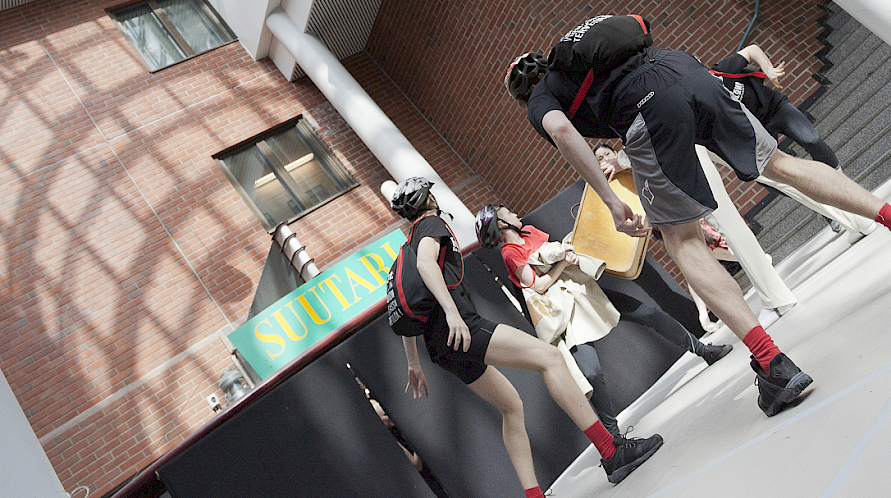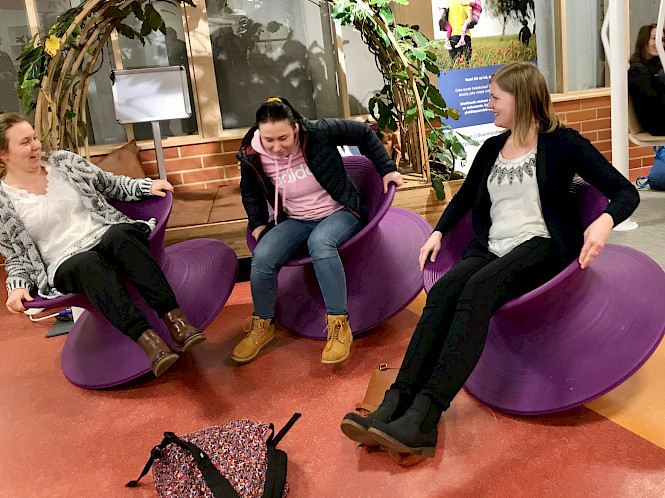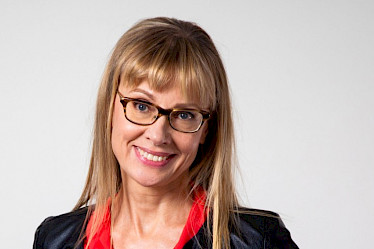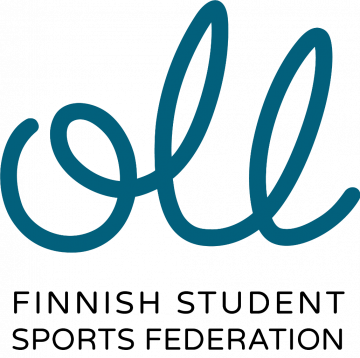Tuire Ranta-Meyer: The playing human has the courage to move in the higher education
In this blog post, I discuss whether universities of applied sciences can have imaginative leaders and “masters of madness”, as in Little’s office. Could a creative idea that seems a little crazy today be a driving force for the development of tomorrow? Are there any aspects of higher education sports where students do not need to be full of athletic power in order to exercise on their own terms, take part in and enjoy physical activity one step – or, say, one wrist rotation at a time?
“In my company, everyone has to learn to be silly and stupid every day. So, I ask my employees when they present, say, a new house design: ‘What if we built it out of marshmallows?’”
It might be difficult to believe but this recipe for success by Bill Little, director of the American architecture firm Little & Associates, is an important underlying ideology of the MyActive Campus project that was launched in Metropolia University of Applied Sciences. How is managing a company related to the project to promote everyday physical activity on Metropolia’s new giant campus in Myllypuro in eastern Helsinki?
The shoemaker’s children
My mother was a physical education teacher but she wasn’t working in the school where I was attending. In her school they were skiing, orienteering, learning gymnastics and figure skating’s salchow-jumps and lining skating arcs. From elsewhere, my skating lessons were limited to our teacher’s request to take 20 rounds on the ice and come out. My mom, mother of four, had only rarely enough energy to teach us, her childrens, into the mystery of moving in her free-time.
Therefore I didn’t even become an amateur athlete. I hitted the baseball only by accident and my high jump stayed under the bar. This was the problem until my sister teached me the Flop style.
Even my own children have been clumsy in sports. Exercising in sports didn’t increase their self-esteem at all. More likely it was distressing and discouraging. The word forcing is bad in education. After it there was nothing to temptate or bribe them to become eager into sports which were available. When living in the centre of Helsinki it was frustrating to pack everything and everyone into a car and drive 10 kilometers to skiing in Paloheinä. Not to mention coming back from Paloheinä after skiing the route of 3 kilometers.
This was insane, but did we have an option?
Learning and physical activity go hand in hand
We all know that it benefits the brain when we exercise, get out of breath, sweat and when our pulse rate increases. Physical activity takes care of the blood vessels in the whole body and also benefits the small blood vessels in the brain. The amount of brain-derived growth factor (neurotrophin) increases significantly right after exercise. This will accelerate the formation of cells in the hippocampus area of the brain.
That’s why it is wise to combine learning difficult things with physical activity: when exercise is combined with an interesting activity, the volume and memory capacity of the hippocampus may increase.

Daily moving at the campus of higher education is meaningfull when you can choose activity what is speaking to you.
According to Aivoliitto, exercise speeds up thinking and improves alertness. Aerobic exercise improves processing speed, executive functions and memory. Exercise can improve cognitive performance quickly. The blood circulation in the brain and the flow of oxygen and food are also accelerated. Endurance sports in particular, such as running, walking, cycling, skiing and swimming, are quite easily accessible to anyone.
There is no shortage of information out there. So why, despite all the information available, do we not always make daily choices that promote our well-being?
Why would we rather sit on a couch or throw ourselves on a beanbag on the campus instead of jumping a skipping rope around the campus or challenging our fellow students to a sack race along the long corridors of the higher education institution? The MyActive Campus project that I started aims to both answer this question and to take active measures to lower the threshold for higher education sports.
The playing human
In everything I do, the starting point is that I should practice what I preach. Why would students suddenly take exercise breaks or hang on the stall bars of the common room or lounge if they never see their teachers or other staff members do these things? How could the accumulation of health capital for future working life be a natural part of the activities of the higher education community if no one talks about it and if it is not seen in the daily life on the campus? How do we ever have the courage to step out of our comfort zone if we are afraid of embarrassing ourselves or that others stare at us?
In order for physical activity to be meaningful, it is important that we can exercise in a way that we like.
There must be some really easy exercise available at a time of day when there are other activities on the campus. Only exceptional individuals have the energy to go to a spinning class on the campus at seven o'clock in the morning or swim 10 kilometres in a public swimming pool before the day’s first lesson or lecture. The rest of us, more common people, need encouragement, reminders, cajoling, persuasion and a collective sense of belonging to a group in order for us to break our usual daily routine for a period of exercise.
We urgently need a more playful culture in higher education and to recognise that learning improves when we can relax just enough, use all our senses to experience the world around us and trust the power of the subconscious.
I have a dream that both teachers and students in universities of applied sciences would stop taking themselves so seriously and that every now and then, they could spend part of their day for, say, sitting on a gym ball, climbing the nearby trees or geocaching related to the theme of their course. Running, climbing, hanging, crawling, sneaking and dancing shape the brain by creating new connections between synapses. Physical activity also releases neurotransmitters in the brain and stimulates plasticity, i.e. the brain's ability to adapt. Who would really want to be set in their ways during their studies and lose their ability to develop? In the words of Gail Sheehy:
“If we don't change, we don't grow. If we don't grow, we aren't really living.”
Free yourself from being performance-centred and taking things too seriously

In a nutshell, I would say that the goal of the MyActive Campus project is to increase the occurrence of homo ludens, or the playing human, on the Myllypuro campus.
According to the philosopher Johan Huizinga, play is a key element in the generation of culture. We should give the playing human some equipment and materials, enough freedom to look for their sport and the courage to be themselves, despite the pressure to adapt. In addition, the playing human must feel mentally safe in the higher education community and feel that they belong to a community which fundamentally takes an appreciative look at its members.
In an ideal scenario, the campus of a higher education institution can become a safe haven for building a strong self-esteem with friendly flashing lights and facilities built for exercise breaks in a relaxed atmosphere.
In the words of Huizinga, the campus can be a magic circle, a boundary between play and the rest of the world, so that you can feel that you are physically capable enough for future working life.
PhD, docent Tuire Ranta-Meyer
Director of Cooperation and Networks in Metropolia UAS, Commissioner of Metropolia-foundation
MyActive Campus is three-year project of Metropolia and student union METKA. Project has been funded by URLUS-foundation and the mission of the project is to create a culture which allures students and staff to adding physical activity in their days from the first day on campus. From the start Ranta-Meyer has been in the process of creating different low-effort at-work exercise places, moving exercises and routes which are fun and easy to do.

You may also be interested in
-
Ruotsinkielinen seminaari Liikkuva Korkeakoulusta 27.11.2020
Published:Finlands Svenska Idrotts järjesti Liikkuva opiskelu -aiheisen seminaarin ruotsiksi 27.11.2020. Seminaariin osallistui Opiskelijoiden Liikuntaliiton puolesta vuoden 2020 varapuheenjohtaja Sanna-Maria Ahl. Hän piti siellä esityksen opettajien merkityksesta osana opiskelijoiden matalankynnyksen liikkumista.
Read more about article: Ruotsinkielinen seminaari Liikkuva Korkeakoulusta 27.11.2020
-
Higher Education on the Move News: Collaboration Makes Wellbeing Easier
Published:Read the latest news from the Higher Education on the Move network!
Read more about article: Higher Education on the Move News: Collaboration Makes Wellbeing Easier
-
Universities on the Move gets stronger – MoE gives OLL a significant grant for further development of Universities on the Move
Published:The Ministry of Education and Culture (MoE) is giving Universities on the Move, which is coordinated by the Finnish Student Sports Federation (OLL), a grant of 90,000 euros for the first year. The project will last three years. The focus lies on finding new solutions which increase the physical everyday activity at universities and to implement these in practice with the university communities.
Share this page
Page last updated 20.5.2021
